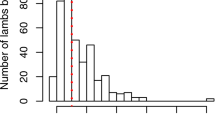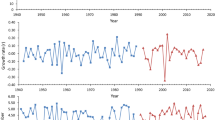Abstract
Anthropogenic climate change and habitat alterations increase the importance of understanding the causes and consequences of variation in phenological traits. Although the timing of phenological events may vary in response to both direct and mediated effects, methods to measure and distinguish direct and mediated effects have seldom been used. We used a Bayesian structural equation model (SEM) to evaluate potential direct and mediated effects of intrinsic individual and environmental factors on the timing and progression of spring molt in bighorn sheep. The SEM showed that molt phenology varied across years, was earlier in prime-aged and in heavier individuals, slower in males, and later in lactating ewes, especially if they were light. These results highlight how individual variation in intrinsic traits and life-history leads to substantial variation in a phenological trait. Indirect effects in the SEM predicted a delay in sheep molt phenology at high population density mediated through negative density effects on body mass and lactation probability. Cooler temperatures in late spring were also predicted to delay molt phenology via a negative effect on body mass. Finally, lactation reduced ewe mass which was predicted to delay molt phenology. This mediated effect thus increased the total delay (sum of direct and mediated effects) in molt phenology experience by lactating ewes. Our results underline the importance of estimating direct and indirect effects when modeling phenological traits. Because indirect effects could substantially affect estimates of total plasticity, they should be critically important to accurately predict phenological mismatches and demographic consequences of environmental change.



Similar content being viewed by others
Availability of data and materials
Data and R code will be made available from the Figshare data repository.
Private URL for data and code access during the submission process is the following: https://figshare.com/s/5327611f422c197bb8cc.
Code availability
Code will be made available from the Figshare data repository.
Private URL for data and code access during the submission process is the following: https://figshare.com/s/5327611f422c197bb8cc.
References
Altmann J (1974) Observational study of behavior: sampling methods. Behaviour 49:227–266. https://doi.org/10.1163/156853974X00534
Beltran RS, Burns JM, Breed GA (2018) Convergence of biannual moulting strategies across birds and mammals. Proc Royal Soc B 285:20180318. https://doi.org/10.1098/rspb.2018.0318
Berteaux D, Réale D, McAdam AG, Boutin S (2004) Keeping pace with fast climate change: can arctic life count on evolution? Integr Comp Biol 44:140–151. https://doi.org/10.1093/icb/44.2.140
Bérubé CH, Festa-Bianchet M, Jorgenson JT (1999) Individual differences, longevity, and reproductive senescence in bighorn ewes. Ecology 80:2555–2565. https://doi.org/10.1890/0012-9658(1999)080[2555:IDLARS]2.0.CO;2
Boily P (1995) Theoretical heat flux in water and habitat selection of phocid seals and beluga whales during the annual molt. J Theor Biol 172:235–244. https://doi.org/10.1006/jtbi.1995.0020
Brown RD, Mote PW (2009) The response of Northern Hemisphere snow cover to a changing climate. J Clim 22:2124–2145. https://doi.org/10.1175/2008JCLI2665.1
Bürkner P-C (2017) brms: an R package for Bayesian multilevel models using stan. J Stat Softw 80:1–28. https://doi.org/10.18637/jss.v080.i01
Caro T (2005) The adaptive significance of coloration in mammals. Bioscience 55:125–136. https://doi.org/10.1641/0006-3568(2005)055[0125:TASOCI]2.0.CO;2
Clough Y (2012) A generalized approach to modeling and estimating indirect effects in ecology. Ecology 93(8):1809–1815. https://doi.org/10.1890/11-1899.1
Conn PB, Johnson DS, Williams PJ, Melin SR, Hooten MB (2018) A guide to Bayesian model checking for ecologists. Ecol Monogr 88:526–542. https://doi.org/10.1002/ecm.1314
Cowan IM, Raddi AG (1972) Pelage and molt in the black-tailed deer (Odocoileus hemionus (Rafinesque)). Can J Zool 50:639–647. https://doi.org/10.1139/z72-088
Déry F, Hamel S, Côté SD (2019) Getting ready for the winter: timing and determinants of molt in an alpine ungulate. Ecol Evol 9:2920–2932. https://doi.org/10.1002/ece3.4970
Dormann CF, McPherson JM, Araujo MB, Bivand R, Bolliger J, Carl G, Davies RG, Hirzel A, Jetz W, Kissling WD, Kuehn I, Ohlemueller R, Peres-Neto PR, Reineking B, Schroeder B, Schurr FM, Wilson R (2013) Collinearity: a review of methods to deal with it and a simulation study evaluating their performance. Ecography 36:27–46. https://doi.org/10.1111/j.1600-0587.2012.07348.x
Douhard M, Pigeon G, Festa-Bianchet M, Coltman DW, Guillemette S, Pelletier F (2017) Environmental and evolutionary effects on horn growth of male bighorn sheep. Oikos 126:1031–1041. https://doi.org/10.1111/oik.03799
Ernakovich JG, Hopping KA, Berdanier AB, Simpson RT, Kachergis EJ, Steltzer H, Wallenstein MD (2014) Predicted responses of arctic and alpine ecosystems to altered seasonality under climate change. Glob Change Biol 20:3256–3269. https://doi.org/10.1111/gcb.12568
Fish FE, Smelstoys J, Baudinette RV, Reynolds PS (2002) Fur doesn’t fly, it floats: buoyancy of pelage in semi-aquatic mammals. Aquat Mamm 28:103–112
Fraser EE, Longstaffe FJ, Fenton MB (2013) Moulting matters: the importance of understanding moulting cycles in bats when using fur for endogenous marker analysis. Can J Zool 91:533–544. https://doi.org/10.1139/cjz-2013-0072
Geist V (1971) Mountain sheep. A study in behavior and evolution. University of Chicago Press
Gelman A, Rubin DB (1992) Inference from iterative simulation using multiple sequences. Stat Sci 7(4):457–472
Gelman A, Carlin JB, Stern HS, Dunson DB, Vehtari A, Rubin DB (2013) Bayesian data analysis. CRC Press
Gienapp P, Teplitsky C, Alho JS, Mills JA, Merilä J (2008) Climate change and evolution: disentangling environmental and genetic responses. Mol Ecol 17:167–178. https://doi.org/10.1111/j.1365-294X.2007.03413.x
Graham MH (2003) Confronting multicollinearity in ecological multiple regression. Ecology 84:2809–2815. https://doi.org/10.1890/02-3114
Hewson R (1958) Moults and winter whitening in the mountain hare Lepus timidus scoticus, Hilzheimer. Proc Zool Soc Lond 131:99–108. https://doi.org/10.1111/j.1096-3642.1958.tb00635.x
Iler AM, CaraDonna PJ, Forrest JR, Post E (2021) Demographic consequences of phenological shifts in response to climate change. Annu Rev Ecol Evol Syst 52:221–245. https://doi.org/10.1146/annurev-ecolsys-011921-032939
Koo TK, Li MY (2016) A guideline of selecting and reporting intraclass correlation coefficients for reliability research. J Chiropr Med 15(2):155–163
Lee SY (2007) Structural equation modeling: a Bayesian approach, vol 711. Wiley
Ling JK (1970) Pelage and molting in wild mammals with special reference to aquatic forms. Q Rev Biol 45:16–54. https://doi.org/10.1086/406361
Mills LS, Zimova M, Oyler J, Running S, Abatzoglou JT, Lukacs PM (2013) Camouflage mismatch in seasonal coat color due to decreased snow duration. Proc Natl Acad Sci 110:7360–7365. https://doi.org/10.1073/pnas.1222724110
Nakagawa S, Schielzeth H (2010) Repeatability for Gaussian and non-Gaussian data: a practical guide for biologists. Biol Rev 85:935–956. https://doi.org/10.1111/j.1469-185X.2010.00141.x
Nowak K, Berger J, Panikowski A, Reid DG, Jacob AL, Newman G, Young NE, Beckmann JP, Richards SA (2020) Using community photography to investigate phenology: a case study of coat molt in the mountain goat (Oreamnos americanus) with missing data. Ecol Evol 10:13488–13499. https://doi.org/10.1002/ece3.6954
Parmesan C (2006) Ecological and evolutionary responses to recent climate change. Annu Rev Ecol Evol Syst 37:637–669. https://doi.org/10.1146/annurev.ecolsys.37.091305.110100
Pedersen S, Odden M, Pedersen HC (2017) Climate change induced molting mismatch? Mountain hare abundance reduced by duration of snow cover and predator abundance. Ecosphere 8:e01722. https://doi.org/10.1002/ecs2.1722
Pérez-Barbería FJ, Nores C (1996) Grazing activity of breeding and non-breeding female Cantabrian chamois (Rupicapra pyrenaica parva). Ethol Ecol Evol 8:353–363. https://doi.org/10.1080/08927014.1996.9522908
Pigliucci M (2001) Phenotypic plasticity: beyond nature and nurture. JHU Press
Plavcan JM (2001) Sexual dimorphism in primate evolution. Am J Phys Anthropol 116:25–53. https://doi.org/10.1002/ajpa.10011
R Core Team (2020) R: A language and environment for statistical computing. R Foundation for Statistical Computing, Vienna, Austria. https://www.R-project.org/.
Réale D, McAdam AG, Boutin S, Berteaux D (2003) Genetic and plastic responses of a northern mammal to climate change. Proc Royal Soc B 270:591–659. https://doi.org/10.1098/rspb.2002.2224
Reed TE, Grøtan V, Jenouvrier S, Sæther BE, Visser ME (2013) Population growth in a wild bird is buffered against phenological mismatch. Science 340:488–491. https://doi.org/10.1126/science.1232870
Rios E, Álvarez-Castaneda ST (2012) Pelage color variation in pocket gophers (Rodentia: Geomyidae) in relation to sex, age and differences in habitat. Mamm Biol 77:160–165. https://doi.org/10.1016/j.mambio.2011.12.003
Root TL, Price JT, Hall KR, Schneider SH, Rosenzweig C, Pounds JA (2003) Fingerprints of global warming on wild animals and plants. Nature 421:57–60. https://doi.org/10.1038/nature01333
Shipley B (2016) Cause and correlation in biology: a user’s guide to path analysis, structural equations and causal inference with R. Cambridge University Press
Stearn SC (1992) The evolution of life histories. Oxford University Press, New York, NY
West PM, Packer C (2002) Sexual selection, temperature, and the lion’s mane. Science 297:1339–1343. https://doi.org/10.1126/science.1073257
Williams GC (1966) Natural selection, the costs of reproduction, and a refinement of Lack’s principle. Am Nat 100:687–690. https://doi.org/10.1086/282461
Williams TD, Allen DD, Groff JM, Glass RL (1992) An analysis of California sea otter (Enhydra lutris) pelage and integument. Mar Mamm Sci 8:1–18. https://doi.org/10.1111/j.1748-7692.1992.tb00120.x
Yuan Y, MacKinnon DP (2009) Bayesian mediation analysis. Psychol Methods 14:301–322. https://doi.org/10.1037/a0016972
Zimova M, Mills LS, Lukacs PM, Mitchell MS (2014) Snowshoe hares display limited phenotypic plasticity to mismatch in seasonal camouflage. Proc Royal Soc B 281:20140029. https://doi.org/10.1098/rspb.2014.0029
Zimova M, Mills LS, Nowak JJ (2016) High fitness costs of climate change-induced camouflage mismatch. Ecol Lett 19:299–307. https://doi.org/10.1111/ele.12568
Zimova M, Hackländer K, Good JM, Melo-Ferreira J, Alves PC, Mills LS (2018) Function and underlying mechanisms of seasonal colour moulting in mammals and birds: what keeps them changing in a warming world? Biol Rev 93:1478–1498. https://doi.org/10.1111/brv.12405
Acknowledgements
We thank all the wildlife biologists, field assistants and graduate students who helped collect data at Ram Mountain throughout the years. We thank J. Jorgenson, C. Feder and A. Hubbs for their contributions to field logistics. The Ram Mountain bighorn sheep research project is financially supported by the Natural Sciences and Engineering Research Council of Canada (Discovery Grants to MFB and FP). Additional support was provided by the Canada Research Chair in Evolutionary Demography and Conservation (grant to FP 2009 and 2014), the Alberta Conservation Association, Alberta Environment and Parks, the Fonds de Recherche Nature et Technologies – Québec, the Ministère de l'Éducation et de l'Enseignement supérieur du Québec and the Université de Sherbrooke.
Funding
This research was funded by the Natural Sciences and Engineering Research Council of Canada (Discovery Grants to MFB and FP), the Canada Research Chair in Evolutionary Demography and Conservation (grant to FP 2009 and 2014), the Alberta Conservation Association, Alberta Environment and Parks, the Fonds de Recherche Nature et Technologies—Québec, the Ministère de l'Éducation et de l'Enseignement supérieur du Québec and the Université de Sherbrooke.
Author information
Authors and Affiliations
Contributions
BL, MFB and FP collected data. BL conceived the project, analyzed the data and wrote the manuscript. MFB and FP contributed to writing and revising the manuscript.
Corresponding author
Ethics declarations
Conflicts of interest
Authors declare no conflicts of interest.
Ethics approval
Animal captures and handling were approved by the Université de Sherbrooke ethical Committee (Protocol MFB01).
Consent to participate
All authors gave written informed consent to participate in this study.
Consent for publication
All authors gave written informed approval for publication in Oecologia of the attached version of the manuscript, data and code.
Additional information
Communicated by Christian Kiffner.
Supplementary Information
Below is the link to the electronic supplementary material.
Rights and permissions
Springer Nature or its licensor holds exclusive rights to this article under a publishing agreement with the author(s) or other rightsholder(s); author self-archiving of the accepted manuscript version of this article is solely governed by the terms of such publishing agreement and applicable law.
About this article
Cite this article
Larue, B., Pelletier, F. & Festa-Bianchet, M. Determinants of spring molt in bighorn sheep: life-history, plasticity and phenology. Oecologia 199, 809–817 (2022). https://doi.org/10.1007/s00442-022-05231-7
Received:
Accepted:
Published:
Issue Date:
DOI: https://doi.org/10.1007/s00442-022-05231-7




